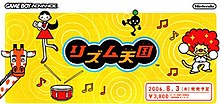| Rhythm Tengoku | |
|---|---|
 Japanese GBA box art | |
| Developer(s) | Nintendo SPD J.P.Room Sega (arcade) |
| Publisher(s) | Nintendo Sega (arcade) |
| Director(s) | Kazuyoshi Osawa |
| Producer(s) | Tsunku Yoshio Sakamoto |
| Designer(s) | Tsunku Kazuyoshi Osawa Yoshio Sakamoto |
| Programmer(s) | Kazuyoshi Ozawa |
| Artist(s) | Ko Takeuchi |
| Composer(s) | Tsunku Masami Yone |
| Series | Rhythm Heaven |
| Platform(s) | Game Boy Advance Arcade |
| Release | Game Boy Advance:
|
| Genre(s) | Rhythm |
| Mode(s) | Single player, multiplayer (Arcade) |
| Arcade system | Sega NAOMI |
Rhythm Tengoku[a] is a rhythm game developed and published by Nintendo for the Game Boy Advance. It was originally released on August 3, 2006, and was the last game released by Nintendo for the Game Boy Advance. An arcade version of the game was reprogrammed and published by Sega[1] on September 20, 2007. Both versions were released in Japan exclusively. The game was the first in the Rhythm Heaven series which spawned three international sequels; Rhythm Heaven, Rhythm Heaven Fever, and Rhythm Heaven Megamix. It began as an idea created by its composer and supervisor Tsunku, who proposed it to Nintendo due to his belief that they could do a better job with it than he could.
Rhythm Tengoku's gameplay focuses on audio cues rather than visual cues to convey information to players. It features a number of unique stages which have their own type of rhythm and gameplay. Players follow the rhythm (in some rhythm games as a character) until the end where they are given a score based on their performance. The gameplay and music were both well received by critics and consumers. Parallels have been drawn between it and the developer's previous work on the WarioWare series.
Cite error: There are <ref group=lower-alpha> tags or {{efn}} templates on this page, but the references will not show without a {{reflist|group=lower-alpha}} template or {{notelist}} template (see the help page).
- ^ "任天堂の大人気リズムゲーム『リズム天国』のアーケード版がセガより今秋登場!". Sega. May 10, 2007. Archived from the original on March 12, 2008.